#Chinese artisan
Text

Food serving vessel (dui)
China
early 6th century BCE
#food serving vessel#Chinese artisan#ceramics#pottery#arts and crafts#asian art#chinese art#chinese culture#chinese history#artifacts#antiquities#aesthetic#beauty#craftsman#art history#aesthetictumblr#tumblraesthetic#tumblrpic#tumblrpictures#tumblr art#tumblrstyle#artists on tumblr
256 notes
·
View notes
Photo







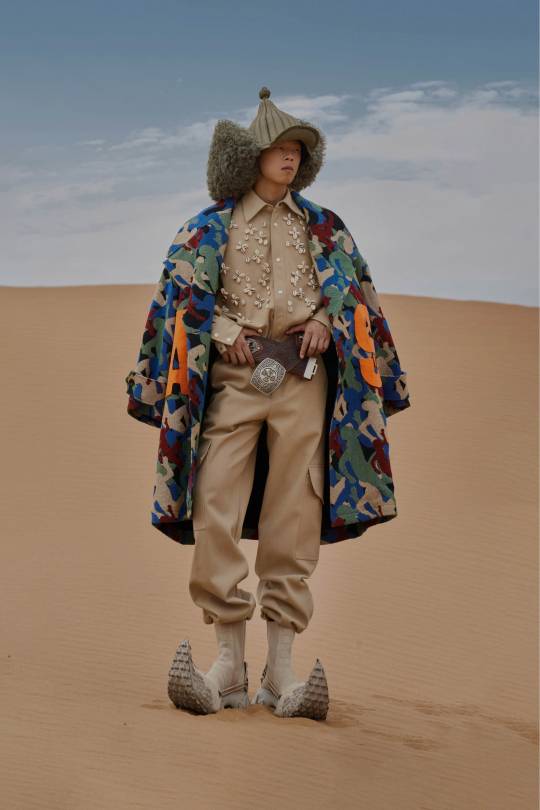
Angel Chen // Fall 2022
119 notes
·
View notes
Note
To Marinette and Kim:
I know it's a little late, but did you have fun celebrating the Chinese and Vietnamese New Years? Marinette, happy year of the Rabbit! Kim, happy year of the Cat!
Marinette: Thank you so much! Maman and Papa got to set up shop at La Place des Fêtes in February of this year, and we made a huge profit!
Kim: Don't let Mme. Cheng catch you saying anything about this year's animal, though. She and Mẹ love to mock-debate over that.
Alix: I need to look into what zodiac sign I am in Arabic again... it's been a while.
Shiho: The Arabic zodiac uses items and weapons instead of animals, right?
Alix and Nino nod in confirmation.

#RYVAL#Miraculous Ladybug#Persona 5#Persona#new year#Marinette Dupain-Cheng#Luck Arcana#Lê Chiến Kim#Captain Arcana#Alix Kubdel#Archangel Arcana#Shiho Suzui#Thunderbolt Arcana#Nino Lahiffe#Artisan Arcana#year of the water rabbit#year of the rabbit#Vietnamese new year#Chinese new year
4 notes
·
View notes
Text
Master Calligraphy in Motion.
#original art#modern art#calligraphy#chinese fashion#chinese new year#mandarin#chinese art#chinese history#oil painting#antique#art history#japanese art#artwork#ink drawing#ink#artisan#wall art#wall prints#wallpaper#home decor#home design#decoration#decor#interior#interior design#bespoke#art investment#wall decor#luxury lifestyle#photography
1 note
·
View note
Text
tgifff :-)
#how r we all..... classes were good it's sunny out!! thrift store had a 50% off sale & i found a pure cashmere sweater & a book of chinese#folk tales..... my ma n i stopped in the french bakery fifteen minutes b4 closing & the person working there had cute soot sprite tattoos &#recommended cherry truffles!! got croissants & some... raspberry chantilly cream puff pastry confection that was delightful n had a#tiny little parking lot picnic next 2 the railroad tracks w her.... through some fortuitous coinkydink we even had a stupid fancy glass#artisan water in the car (1.50 at natural grocers) & it was just. so nice :] very undertale#fills you with determination...^_^ anyway.tgif!!#txt
1 note
·
View note
Text

#artisan bread#cottage bakery#homemade#homemade bread#artisan#baking#sourdough starter#pineapple bun#hong kong#chinese bakery#sourdough bread
0 notes
Text
there's currently a free japanese indie film festival being held online! all the films have subtitles in english, spanish (latin america), thai, indonesian, simplified chinese, and traditional chinese
and the films are available to watch worldwide (except japan and some others depending on the movie):
bachiranun (2021)
tenzo (2019), not available in france, belgium, switzerland, korea
an artisan's legacy, tsunekazu-nishioka (2012)
lonely glory (2022)
hanagatami (2017), not available in china, us, canada, uk, and ireland
bon-uta, a song from home (2019)
and your bird can sing (2018), not available in korea, china, taiwan, us, and canada
hey! our dear don-chan (2022)
techno brothers (2023)
a muse never drowns (2022), not available in the netherlands, and canada
a girl in my room (2022), not available in korea, china, and taiwan
follow the light (2021)
the festival will be held until october 31, 2023 :))
#not sponsored or anything just thought y'all might be interested :))#also what i mean is none of the films are available to watch online in japan because the film festival is in-person there#also i think the ones where films aren't available in certain countries is because they're also being shown at in-person festivals?#ofc you can always vpn those or something#reference#ok to rb#EDIT: turning off reblogs because the festival is over :)
6K notes
·
View notes
Text
youtube
#This royal house#which stands in the Capital city Agartala covering one sq.Km. area was built by Maharaja Radha Kishore Manikya during 1899-1901.It is a two#having a mixed type of architecture with three high domes#the central one being 86′ high. The magnificent tile floor#curved wooden ceiling and beautifully crafted doors are particularly notable. The palace is set with huge Mughal style gardens#beautified by pools and gardens and tiled floors. Flood lighting and fountains have also added to its beauty.The magnificent tiles floors#ceiling of the Chinese room crafted by artisans brought from China#of the palace which now houses the State Legislative Assembly#may give some idea of the opulence and splendor of the original setting of the building. It has recently been adorned with a spectacular mu#Early in the museum's history#controversy erupted over the state government's proposed move to change the name of Ujjayanta Palace to Tripura State Museum. The Indigenou#Hamid Ansari#protesting that the name of the museum should reflect the history and heritage of the region. Pradyut Bikram Kishore Debbarma#the titular king of Tripura said#"The palace is a historical spot. It doesn’t belong to the members of the erstwhile royal family alone#neither does it solely belongs to the government. It belongs to Tripura and somebody in the government can’t suddenly impose a decision to#FOLLOW ME:#Facebook: https://www.facebook.com/karimmufte/#Instagram: https://www.instagram.com/karimmufte/#LinkIn: https://www.linkedin.com/in/mahamudul...#Twitter: https://twitter.com/karimmufte#Youtube: http://www.youtube.com/c/MahamudulKar...#• Licence:#Song: Ikson - Paradise (Vlog No Copyright Music)#Music promoted by Vlog No Copyright Music.#Video Link: https://youtu.be/glMhD3EU46k#Song: Acn8 - If The World Was Ending#Music provided by Vlog No Copyright Music.#Video Link: https://youtu.be/6kxyHxzilug#GoProHERO9
1 note
·
View note
Text
The Cast and Crew Don’t Deserve Your Hate
I know many of us feel hurt and betrayed by NATLA. I know this. I feel the same.
Please stop cursing Albert Kim and the production crew. The fact is, he inherited a huge mess that was already behind schedule. Studios nowadays want the fastest turn around possible and are willing to pour money into projects.
But not time.
I’ve said it before, but LOTR is the absolute gold standard for production. They took years of pre-production time to hand craft their costumes and props and wigs. They hired artisans to hand make tunics and chainmail by hand. They sourced and layered real human hair for their hair pieces. It was incredible.
GOT also attempted something similar though not nearly at the same scale.
That’s why both of these productions have such fantastic and realistic feeling costumes, wigs, and props.
Modern studios just want fast turn around. They’ll pour in money but they want it fast. That’s why the modern takes on LOTR and GOT (ROP and HOTD) look like mediocre cosplay by comparison. The stylists are doing their best, but there’s only so much you can do with so little time.
That’s exactly what’s happened here. You can tell in how awful all the wigs and beards look, even compared to the Shyamalan film of all things! It’s why you can see machine stitching and the fabrics aren’t thick enough to pass for animal pelts. It’s why Iroh’s beard looks like it’s going to fall off, and Yue’s hair looks like a Lego piece, and Azula’s bangs are visibly attached extensions of a completely different sort from the rest of the synthetic wig. It’s why Zuko’s scar looks like a birthmark and not a burn.
It’s why the bending, despite having impressive animation, doesn’t line up well with the actors’ movements and feels pasted on. Almost as if the artists and fight choreographers didn’t get to communicate and plan together.
It’s why the scripts are a poorly juggled mish mash of plots, with threads left to hang in the wind while others are so oversimplified that it feels like a playschool version of ATLA rather then the “adult” version it’s supposed to be.
And it’s why the the Chinese writing is grammatically a mess like they just ran it through Google translate.
I have nothing but respect for Albert Kim and the cast and crew that worked tirelessly to bring this disaster to life under these conditions.
I worry about the poor crew being put through some awful crunch time for this show…
Yes it’s bad. But it’s not only bad as a piece of media. It’s bad as an indicator of what studios prioritize now, and it’s neither audiences nor their own staff.
767 notes
·
View notes
Text
i literally spend at least 2 hours a week just looking at various pictures of the terracotta army. utterly entranced. look at the details in the hair. you'd never see ANY of this when they're lined up in formation, but they're there.
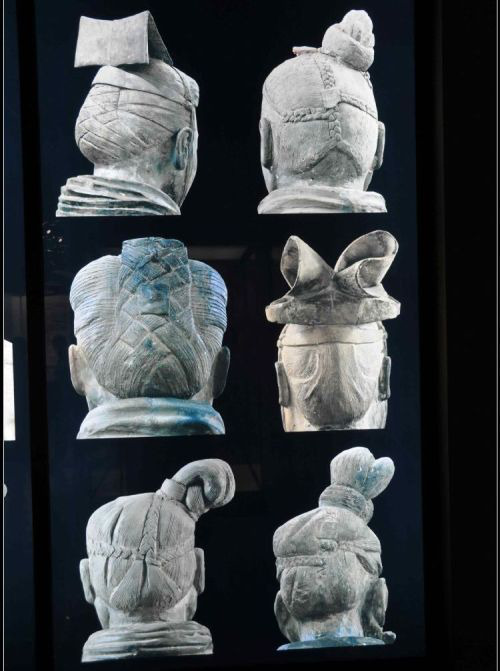
theres about 8000 of these guys down there, no two faces are alike. they're works of art. they're the manifestation of a cruel despot's delusions of grandeur. a talisman against the terrible inevitability of death, both pathetic and strangely pitiful. like watching a child clinging to his blanket, begging you not to turn off the light. they were a bunch of insignificant clay statues from a side chamber that was so small and unremarkable, no one bothered to write down the location. they were modelled after real people. their only purpose was to serve qin shi huang in the afterlife, so he could reign in heaven as he did on earth. now the emperor is just a ghost and his pawns are immortal. my dad and i visited them in the dead of winter, on a weekday, just so we wouldn't have to deal with tourists like us. the place had easily 500 people--not including the ones below ground. we traveled to xian via the old "green skin" diesel train. there are faster means, like highspeed rail but dad insisted i try the authentic way, the same way he would have traveled when he was my age it was also like, a quarter of the price but im sure that had nothing to do with it! back in the 80s carriages would get so packed people had to have their luggage passed in via the windows. as we chugged along, i read my book and my dad made us cup noodles. car is just a shortened version of "carriage", the word is the same but the mechanism is different. it's the same in chinese. i think if i told someone from the warring states period i could travel from the Kingdom of Qi to Qin in just four hours with my metal carriage, i'd be laughed out of town--or accused of being a spy and sentenced to 'death by carriage.' we hopped off the train at 4am and took a different "carriage." the taxi driver joked; "basically every dynasty put their capital in xian, stick a shovel anywhere and you'll turn up some national treasure or another." i wonder what it would have felt like to be a farmer digging a well and then out pops a remarkably realistic human head. statistical analysis show the soldier's faces bear a strong similarity to people living in the region today. the taxi stopped in front of a jewellery-hawking tourist trap and refused budge an inch until we went inside. did you know the terracotta soldiers were originally multi-coloured and painfully gaudy, just like the greek marbles? they were made assembly-line style. the arms and legs were made from the same workshops that made clay plumbing pipes and roof tiles. for quality control, the artisans were required to stamp their names. the workers who built these tombs were executed shortly afterwards, because only dead men can be trusted with secrets. qin shi huang's mausoleum is unlikely to be excavated in my father's lifetime, or mine, not unless i'm willing to take a BIG ONE for the team... instead of the tomb, they built some kind of qin shi huang-themed theme park next to it. not only was it tacky as hell the entrance fee was like $50. we went to the museum and i looked at bronze tools and pottery shards for three hours. look why can't we just crack the thing open i can't be the only one here whos dying from curiosity what if we all just took turns digging
#qin shi huangs terracotta army#warring states#qin dynasty#thinking about Her...<3 bronze tools and pottery shards <3#my writing
1K notes
·
View notes
Text
it goes without explanation with zhou's new helmet is dope as hell. i will provide explanation anyways.

(above, zhou's helmet design as posted to the KV design twitter)
the central design on zhou's helmet is almost certainly inspired by the traditional craft of mother-of-pearl inlay in lacquerware, a practice which originated in China over 6 thousand years ago, and which has been developed and practiced in discrete forms historically in Korea and Japan alike. (continued under the cut!)

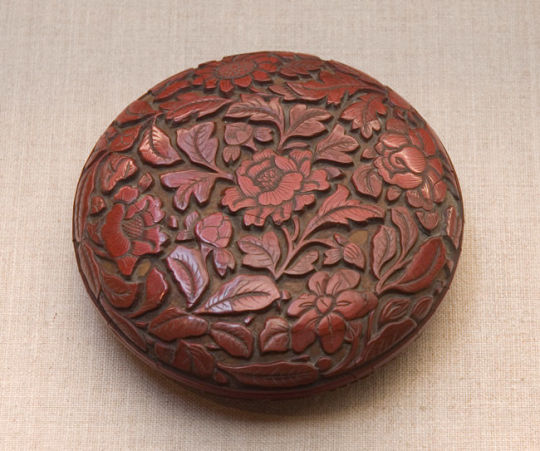
(on the left, a korean (goryeo dynasty) lacquerware stationery box; on the right, a chinese (song dynasty) lacquerware lidded bowl for cosmetics or incense. both photos via the met museum website)
traditionally, lacquerware is created through the refinement of a toxic plant sap into a naturally deep and glossy adhesive coat that is built up and polished often on top of wooden furniture and decorative items, such as chests and jewelry boxes. in the above examples, you can see two types of lacquerware practice.
on the left is mother-of-pearl inlay, which is created through the careful grinding down of tortoise or abalone shell into thin iridescent sheets which are then carefully cut into shape and imbedded into the coats of dark lacquer, being repeatedly covered and then polished down in the lacquer until the shiny shell surface is level with its surroundings. it's both visually stunning and incredibly labor-intensive: for a case like this, there would have been separate artisans making the wooden base box, making the metalware (hinges and clasps) for the box, applying the base layers of lacquer, and then completing the inlay itself.
on the right is (what i understand to be) a predominantly chinese lacquer practice, which is carving into the layers of lacquer to form images in relief. while this practice is not replicated on zhou's helmet, the image selected does display the pattern of the peony flower, which i believe to be the flower depicted in the inlay! the striations of the central petals seem to match zhou's. of course, this is speculative and only based off an amateur's eye, especially considering the motif of scrolling foliage is fairly ubiquitous and somewhat generic in east asian decorative art.


(on the left, zhou's 2024 helmet (detail). on the right, a detail image of a korean chest decorated with mother-of-pearl. zhou's helmet via twitter, right image via the met museum website)
the 'metallic' or 'holographic' effect a lot of people have recognized is a natural property of polished mother-of-pearl: look at the iridescence of the design! while it has been exaggerated to some extent on zhou's helmet (for good effect, i must say), you can clearly see the inspiration when compared side-by-side with a more predominantly mother-of-pearl composition: the variegation between blues, greens, and warmer peachy-reds is mesmerizing.
i really want to drive home how brilliant of a design this is and give the due appreciation to KV Design, who made this helmet for zhou. clearly a lot of thought and creativity went into it, and I can't wait to see it in action. >:D
264 notes
·
View notes
Text
As trade between the Philippines and Mexico grew, artisans in Mexico began to copy Asian porcelain, making cheaper copies of the iconic blue-and-white Chinese patterns. Here’s a chocolate jar made in Pueblo around 1700:
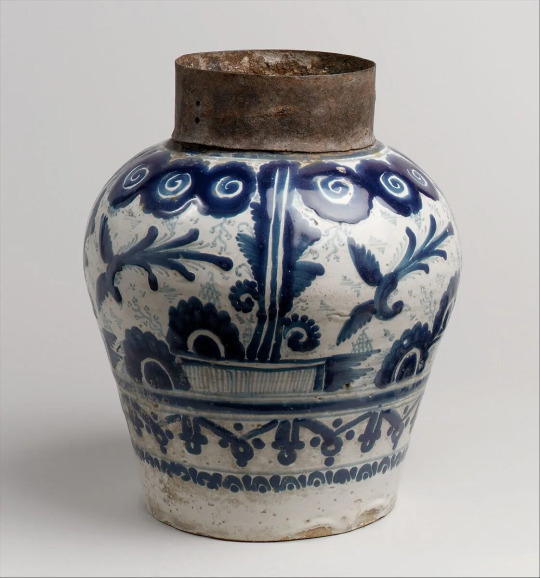
And a more detailed jar:

See more here:
{Buy me a coffee} {WHF} {Medium} {Substack}
295 notes
·
View notes
Text
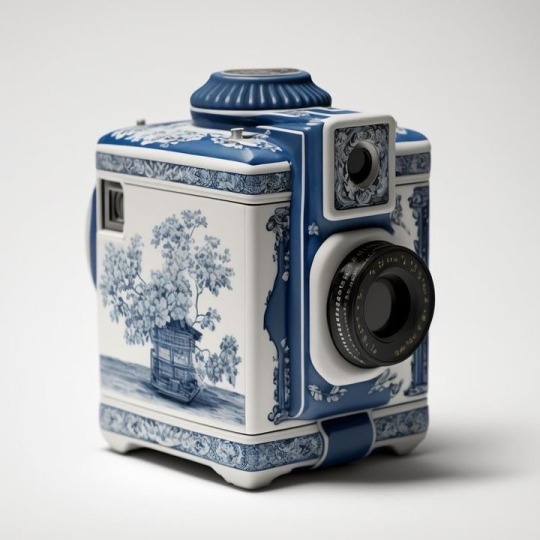

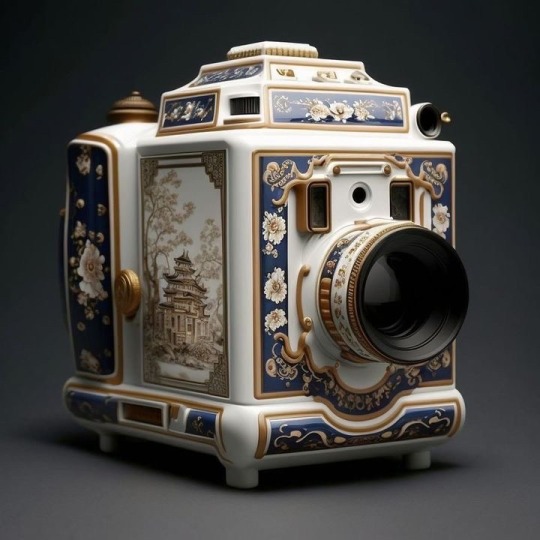

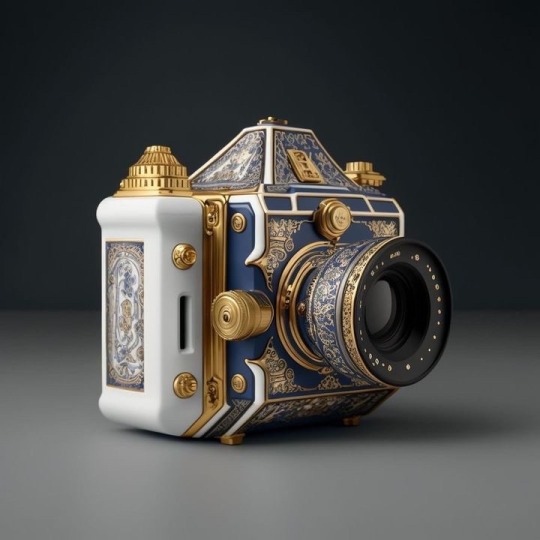
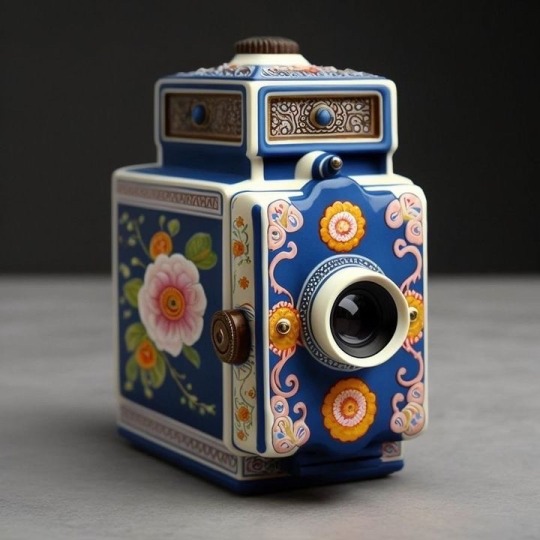



L o v E 🎥
@chiaranonino @mathieustern “Once, The great Chinese Emperor Qianlong became fascinated by the art of photography. He was particularly enamored with the intricacies of the cameras and the beautiful images they produced. The Emperor was so taken with photography that he ordered his finest artisans to create a camera made entirely of porcelain.
The artisans worked tirelessly to create a masterpiece that would please the Emperor. They carefully crafted each piece of the camera by hand, using the finest kaolin clay and the most delicate of designs. When the camera was finished, it was a thing of beauty. The blue and white porcelain shimmered in the light, and the intricate designs and details were truly breathtaking.
The Emperor was delighted with the camera, and he immediately ordered his court photographer to use it to take portraits of him and his court. The resulting images were stunning, and the Emperor was so pleased with the camera that he ordered several more to be made for his court photographers. The porcelain cameras became a symbol of the Emperor's love for photography and his admiration for the artisans who had created them.”
Background ℹ️ ThanX @thelifeofrylee
#midjourney #aiart #fable via @ainterestingaf #mathieustern #chiaranonino for my beloved soul @wetwicksdry 🤎
#3D#3dmodel#octane#octanerender#mdcommunity#noface#3dart#surreal#maxon#cinema4d#c4d#artwork#psychedelic#poster#photoshop#illustration#smoker#graphism#graphic#art#digitalart#otoy#3dillustration#3dartist
#Nowplaying memories by waldeck
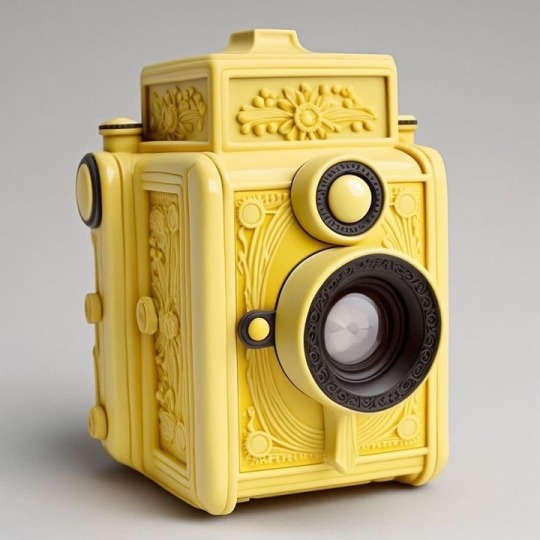
#l o v e#nostalgia#12/2022#3d sculpting#3drender#3d model#3d charms#3d work#3d artist#3d cgi#3d#mathieu stern#chiaranonino#3d render#render#midjourney#newcontemporary#new contemporary art#fucking favorite#music and art#now playing#contemporaryart#Leica#vintage#analog photography#x-heesy#pop art#art post#artist profile#alltime favorite
2K notes
·
View notes
Text


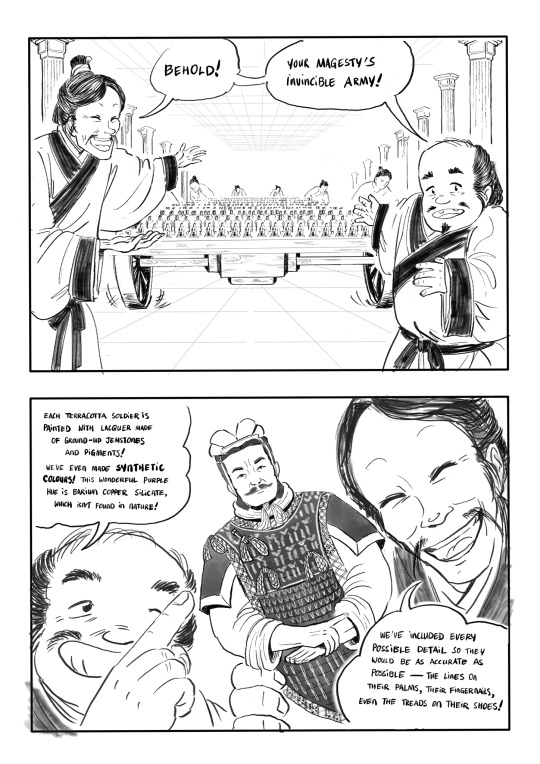
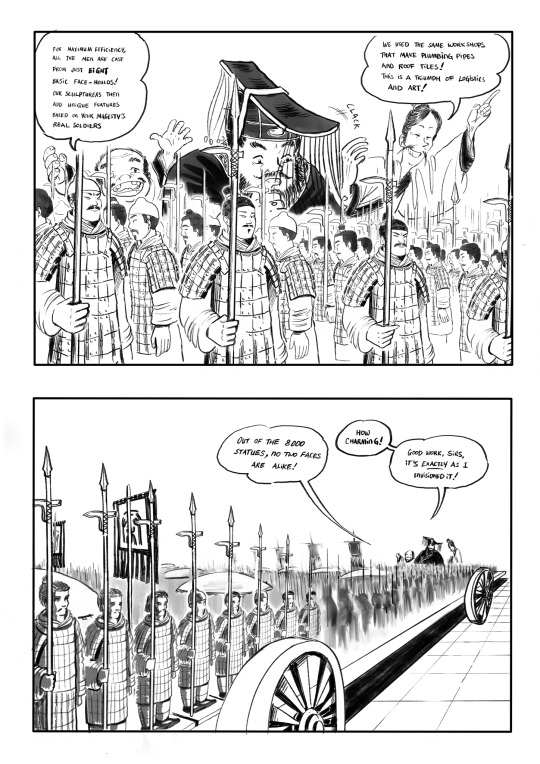

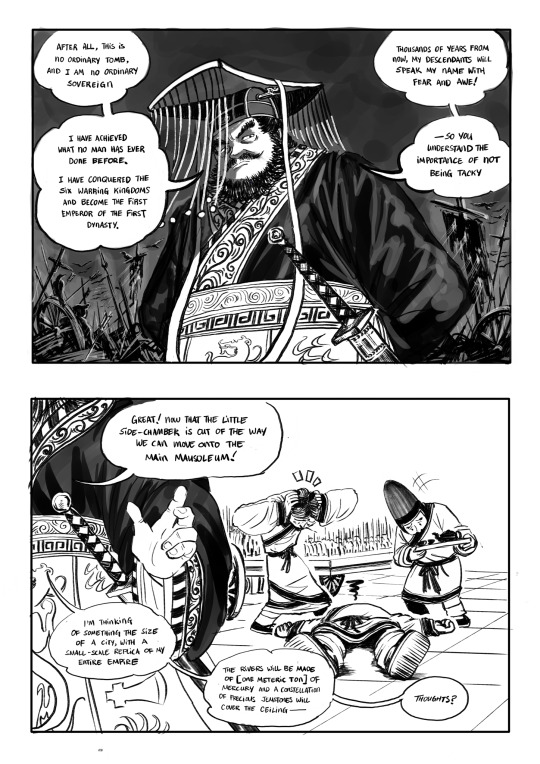
—Terracotta—
Ok so I visited xi'an during my trip back to china (3 months ago?), and this idea popped into my head during the 9h train ride back to shangdong. I am of course 100% projecting my own love of the terracotta army onto Qin Shi Huang, in reality he did not care for this pit of mud statues depicting lowly commoners. In fact, no one ever bothered to write about it and they were lost to history until 1974 when some farmers digging a well stumbled upon them. But it's exactly the reason I'm so fascinated by them. QSH's tomb has not been excavated, and although I have a running joke about cracking it open--mercury vapors be damned--none of the riches inside will ever enchant me as much as the chance to see the face of a person who lived during this time.
Notes under the cut:
#1
the title Qin Shi Huangdi means "First Emperor of Qin" and was given to QSH by later historians. He actually called himself the Shi Huangdi, "First Emperor", and that is the title I've gone with here.
in English the other kingdoms are translated as "states" (i guess to avoid confusion?) but in chinese they are very much kingdoms.
The terracotta warriors used thousands of craftsmen, many of whom were slaves from conquered kingdoms. From a storytelling perspective I thought it would be more streamlined if there were two main artisans who reported directly to QSH.
QSH's clothes are based on the overly complicated courtly regalia. which has 12 symbols that only the emperor is allowed to wear
Notice how this hat is ROUND at the front??? Well I CERTAINLY DIDN'T. HAD TO REDRAW IT!!!!!
the stripped shirt is based on this Chu woman figurine. Clothes were fairly unisex during this time and I thought it was a nice fit.
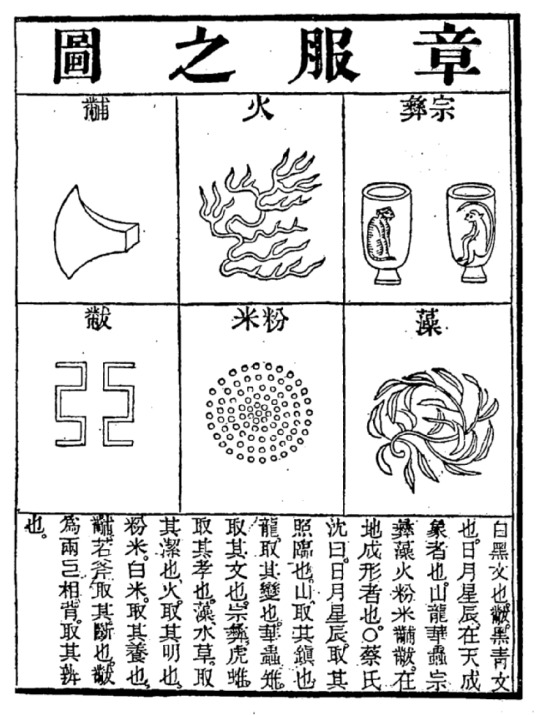
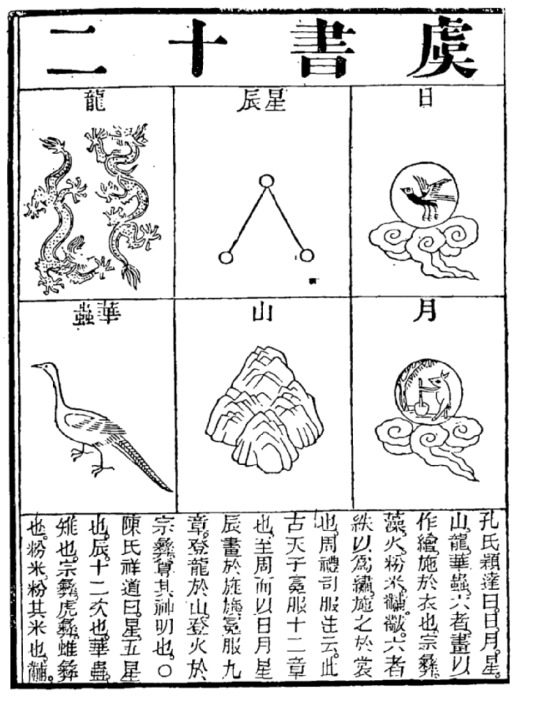



#2
Paperwork: writing was done on books made of bamboo slips. Anecdotally, QSH had an impressive work ethic and would read 100 bills every night.
Bronze Goose lamp: ok this is actually a Han dynasty lamp pls forgive me. I saw this bad boy at the xi'an history museum and it's bewitched me body and soul. The goose neck is hollow and connects to a reservoir of water in the belly, which minimizes smoke and cools the lamp.
QSH is remembered as a brutal tyrant and brilliant statesman, but I wanted to present a more human version of him here. Bored, tired and drowning in work he refuses to delegate. His new empire is balanced as precariously as everything else on his desk.
#3
The attendants standing behind him are holding little wood tablets called hu for taking notes. Their brushes are tucked into their hats/hair, inspired by Han dynasty custom. (You'll see me using Han stuff a lot. Their cultures were very similar to Qin, since it was only a few hundred years apart).
So I had a slight breakdown trying to find the correct hats for the eunuchs, and ended up redrawing everything the night I was due to publish. Closest thing I could come up with was a reference to a round-style Han Dynasty hat which evolved into this square Jin hat. Yes, this is a cry for help .
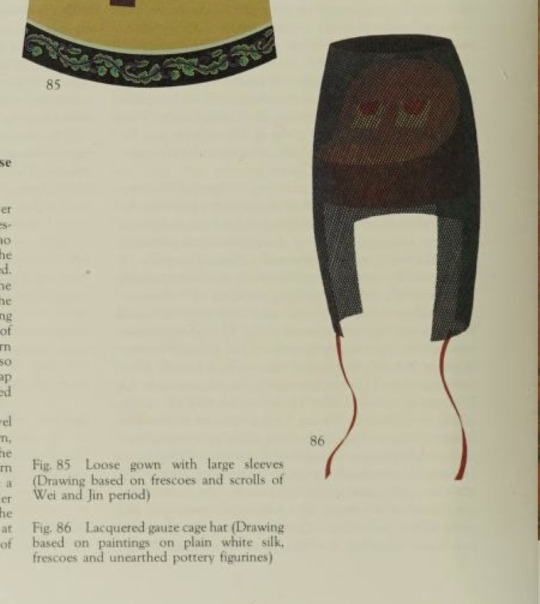
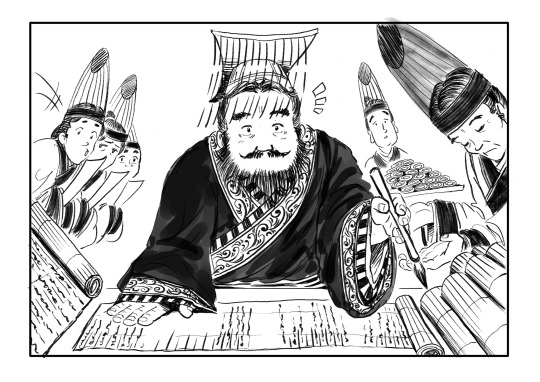
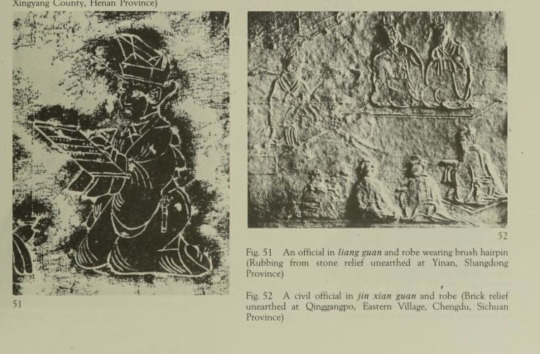
#4
the wheeled platform is 100% made up, I tried to come up with a plausible way of getting a bunch of figurines into the palace.
#5 & #6
Painted terracotta soldier
How were the terracotta warriors made
The General: Fun fact, I got to see this guy in person!
#7
The Epic Wide Shot was inspired by some Tang Dynasty terracotta figures I saw at the xi'an museum!
#8
THIS KNEELING ARCHER. ARGGGGG. He use to be my favourite guy. I even went into the pit and drew him IN PERSON. the archers inexplicably have their hair buns on the OPPOSITE SIDE OF THE HEAD. So because of him, I DREW ALL THE HAIR BUNS WRONG!!!! REDRAW!!!! PAIN AND SUFFERING!!!!

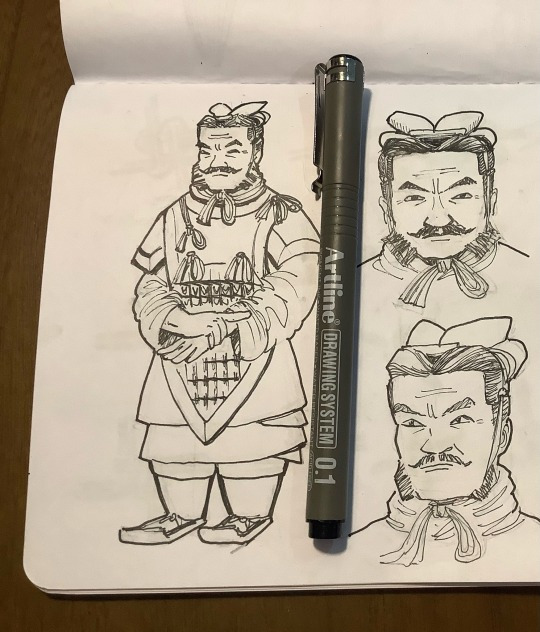
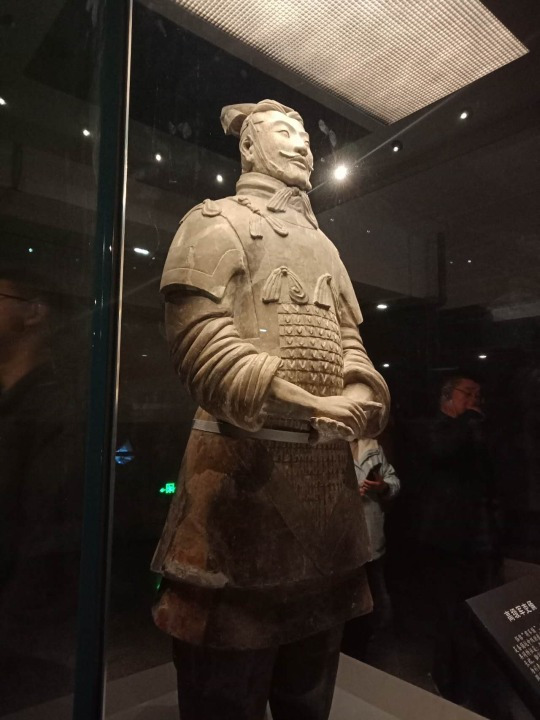
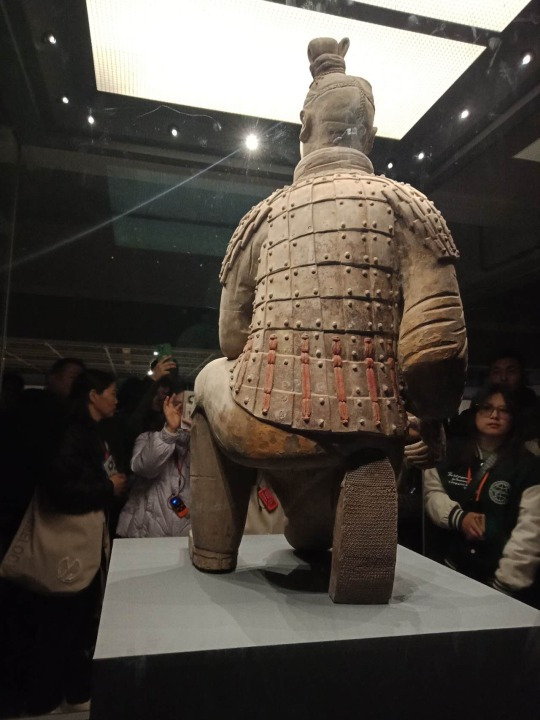


#10
Qin was famous for it's very long, thin swords. They were more useful as status symbols than actual weapons, as QSH knows from personal experience…
#11
QSH'S Tomb hasn't been excavated yet, but high levels of mercury have been detected in the soil, making the historical accounts of quite plausible.
#chinese history#warring states period#qin dynasty#qin shi huang#terracotta army#comics#my art comes with homework lol#art
201 notes
·
View notes
Text
Asian slaves, indigenous Americans, and identity in colonial era Mexico
The Spanish Philippines had a diverse slave population for local labor and export, including Filipino Indians [i.e. natives; indios], Muslim war captives (moros), and foreign slaves from as far away as Portuguese India.
… Upon their arrival, chino slaves [i.e. any Asian slave, not just Chinese] were absorbed by the urban economy of Mexico City, where they mainly worked as domestic servants or in textile mills (obrajes) … For their part, working in the city provided chinos with some possibilities for manumission. Chinos in domestic service were especially apt to embrace the limited opportunities available to them and to experience some social mobility. In the obrajes, chinos had few of the freedoms given to domestic servants, but they did benefit from government oversight of the industry. During official visits, chino slaves appealed for protection from overt exploitation by claiming that they were Indians (even if they were from Portuguese India). Remarkably, visiting inspectors listened to their complaints, and they often responded by liberating individual chinos under the assumption that they were indeed native vassals and could thus not be held in bondage. The overall experience of chinos in the viceroyal capital confirms the benefits of living close to the center of colonial power.
The presence of free indigenous immigrants from the Spanish Philippines in Mexico reinforced the idea that all chinos were Indians. The complex governing structure of colonial Mexico involved two republics or political communities (the república de indios and the república de españoles); this organization separated the indigenous majority from everyone else to facilitate the collection of tribute and the ministry of the Catholic Church … [N]ative immigrants from the Philippines purposely sought to confirm their membership in the Republic because corporate status provided personal advantages. They asked to be tallied in tribute rolls in Mexico to benefit from concomitant privileges, such as trading rights and legal representation through the General Indian Court. At the same time, free Filipinos were frequently confused with chino slaves - a situation that had serious consequences for Filipinos' relations with colonial institutions and enslaved individuals. Some immigrants resented having their indigenous identity questioned and sought to maintain a sense of their Indian-ness by keeping their distance from chino slaves. The majority, however, expressed solidarity with chino slaves. Filipino artisans, for example, took on chino slaves as apprentices and taught them marketable skills. Similarly, Filipino traders incorporated chinos into their own credit networks to facilitate self-purchase.
Individual chinos who were manumitted also embraced an Indian identity, regardless of whether they were from Goa, Macau, or other places in South and Southeast Asia. In this way, chinos challenged official attempts to define them solely as former slaves. Instead, they sought to join the free republic. The possibility for this kind of social integration caused widespread concern among slave owners. To defend their property rights, masters started to brand chino slaves on the face, rather than on the chest or arm as they did with Africans, in order to dissuade them from fleeing and "passing" as free Indians. This horrifying development shows that Indian communities welcomed runaway chino slaves and, by extension, that slave owners sought visible markers of their slaves' status.
Excerpt from the Introduction to “Asian Slaves in Colonial Mexico: From Chinos to Indians” (2014) by Tatiana Seijas
111 notes
·
View notes
Text
Robe à la Française
French, ca. 1770

The robe à la française, with open robe and petticoat, was the quintessential dress of the eighteenth century. Characteristic of 1770s costume are the piece's low neckline, fitted bodice, narrow sleeves with double layered cuffs, as well as the sack back and fullness at the hips supported by panniers. This exquisite example is constructed from a rare Chinese export silk dating from the first quarter of the eighteenth century. The textile is an ivory "bizarre" patterned damask (created by reversing the weave structure so that both the warp-float and weft-float faces of the satin are on the same surface).
As early as the late sixteenth century, Chinese craftsmen created silks for the European market, which were exported by the East India companies of England, France, and Holland. Due to the exchange of design motifs by both Eastern and Western artisans, Chinese export silks often bore little relation to traditional Chinese aesthetics. While this patterned damask closely resembles the European "bizarre" silks popular during the first quarter of the eighteenth century, the selvedge-to-selvedge width, fabric weight, and selvedge markings all indicate Chinese manufacture. To fully appreciate the sumptuousness of this dress, one might imagine the sense of movement candlelight would have created across its surface.
The MET Museum
206 notes
·
View notes